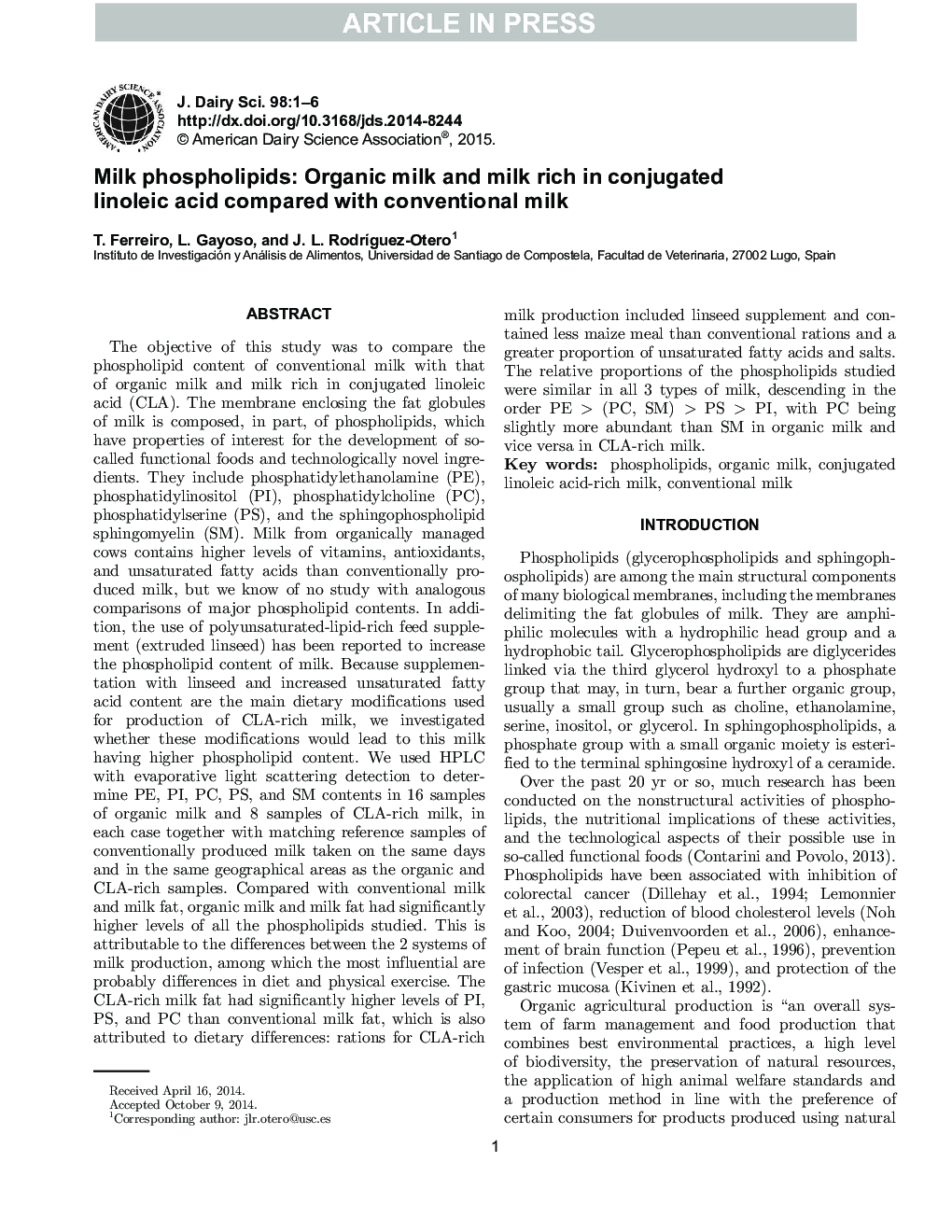| کد مقاله | کد نشریه | سال انتشار | مقاله انگلیسی | نسخه تمام متن |
|---|---|---|---|---|
| 10973711 | 1108019 | 2015 | 6 صفحه PDF | دانلود رایگان |
عنوان انگلیسی مقاله ISI
Milk phospholipids: Organic milk and milk rich in conjugated linoleic acid compared with conventional milk
ترجمه فارسی عنوان
شیر فسفولیپید: شیر آلی و غنی از اسید لینولئیک کنجوج در مقایسه با شیر معمولی
دانلود مقاله + سفارش ترجمه
دانلود مقاله ISI انگلیسی
رایگان برای ایرانیان
کلمات کلیدی
فسفولیپید ها، شیر آلی، شیر غنی از اسید لینولئیک، شیر معمولی
موضوعات مرتبط
علوم زیستی و بیوفناوری
علوم کشاورزی و بیولوژیک
علوم دامی و جانورشناسی
چکیده انگلیسی
The objective of this study was to compare the phospholipid content of conventional milk with that of organic milk and milk rich in conjugated linoleic acid (CLA). The membrane enclosing the fat globules of milk is composed, in part, of phospholipids, which have properties of interest for the development of so-called functional foods and technologically novel ingredients. They include phosphatidylethanolamine (PE), phosphatidylinositol (PI), phosphatidylcholine (PC), phosphatidylserine (PS), and the sphingophospholipid sphingomyelin (SM). Milk from organically managed cows contains higher levels of vitamins, antioxidants, and unsaturated fatty acids than conventionally produced milk, but we know of no study with analogous comparisons of major phospholipid contents. In addition, the use of polyunsaturated-lipid-rich feed supplement (extruded linseed) has been reported to increase the phospholipid content of milk. Because supplementation with linseed and increased unsaturated fatty acid content are the main dietary modifications used for production of CLA-rich milk, we investigated whether these modifications would lead to this milk having higher phospholipid content. We used HPLC with evaporative light scattering detection to determine PE, PI, PC, PS, and SM contents in 16 samples of organic milk and 8 samples of CLA-rich milk, in each case together with matching reference samples of conventionally produced milk taken on the same days and in the same geographical areas as the organic and CLA-rich samples. Compared with conventional milk and milk fat, organic milk and milk fat had significantly higher levels of all the phospholipids studied. This is attributable to the differences between the 2 systems of milk production, among which the most influential are probably differences in diet and physical exercise. The CLA-rich milk fat had significantly higher levels of PI, PS, and PC than conventional milk fat, which is also attributed to dietary differences: rations for CLA-rich milk production included linseed supplement and contained less maize meal than conventional rations and a greater proportion of unsaturated fatty acids and salts. The relative proportions of the phospholipids studied were similar in all 3 types of milk, descending in the order PEÂ >Â (PC, SM)Â >Â PSÂ >Â PI, with PC being slightly more abundant than SM in organic milk and vice versa in CLA-rich milk.
ناشر
Database: Elsevier - ScienceDirect (ساینس دایرکت)
Journal: Journal of Dairy Science - Volume 98, Issue 1, January 2015, Pages 9-14
Journal: Journal of Dairy Science - Volume 98, Issue 1, January 2015, Pages 9-14
نویسندگان
T. Ferreiro, L. Gayoso, J.L. RodrÃguez-Otero,
